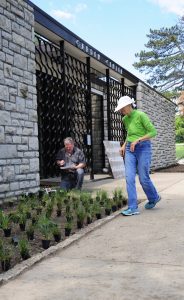 Article via Kansas City Native Plant Initiative. View more pictures on their website>>
Article via Kansas City Native Plant Initiative. View more pictures on their website>>
After a week’s delay due to rain and soggy conditions, the Jean Mary Love Blackman Native Plant Gardens were finally planted on Tuesday, May 30. These two new native plant gardens designed by former Powell Gardens Director of Horticulture Alan Branhagen, are located in front of the Loose Park Garden Center, right across the sidewalk from the existing Loose Park Monarch Demonstration Garden. Seven volunteers from The Westport Garden Club completed the planting under the direction of retired Powell Gardens’ Executive Director Eric Tschanz.
In 2015 Burroughs Audubon was awarded a grant from the National Fish & Wildlife Foundation Monarch Conservation Fund, a part of which included the installation of the Loose Park Monarch Demonstration Garden. Partners in the Kansas City Native Plant Initiative (KCNPI) worked together to made this garden a reality. Powell Gardens’ Alan Branhagen designed the garden, KC Parks provided the space and maintenance support. Westport Garden Club members volunteered to plant and maintain the garden. The Grow Native! organization helps citizens plant their own native gardens by working with local retailers to make native plants available and by providing information on their website.
The interest and enthusiasm in the Monarch Demonstration Garden led several private donors to contribute the funds to create an example of how to use native plants in shady areas. The partners are collaborating in the same roles as before, and the gardens are named in honor of a resident who lived near and dearly loved Loose Park. Well over 500 native plants were included in the design, all with benefit to wildlife, attracting birds, butterflies and other pollinators. The foundation of the garden is a matrix of three sedges: Carex jamesii, Carex radiata and Carex blanda. More than 300 plants of just these three sedge species went into the two beds to form the structure into which other shade loving natives were nestled. Additional species include wild ginger, bloodroot, bluebells, leatherwoods, blue-eyed grass, jack-in-the-pulpit and more.
An orderly layout was accomplished using a custom-made jig with holes drilled every 12 inches, and a bag of flour. A small sprinkling in each hole and the bed was ready to plant without the use of spray paint or string. Flour dots made placement of the long rows of sedges easy, and then the other plants were tucked between and around as called for in the design.
The Jean Mary Love Blackman Native Plant Gardens next to the building showcase many shade plants. The Monarch Demonstration Garden displays an array of plants that thrive in the sun. Learn about plant selection and garden design from these gardens. Alan has selected plants that are appropriate for urban and suburban gardens. Choose native plants that come with the added benefit of being low maintenance. Most non-native plants have little or no value to the nature we love and the natural services we depend on; these plants help control storm water and keep water clean, sequester carbon and clean the air. In addition, every third bite we eat is dependent on the pollinators that native plants feed. Bring interest and beauty into your own yard.